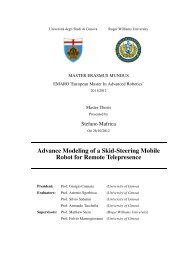Architecture Program Report Master of Architecture - Roger Williams ...
Architecture Program Report Master of Architecture - Roger Williams ...
Architecture Program Report Master of Architecture - Roger Williams ...
Create successful ePaper yourself
Turn your PDF publications into a flip-book with our unique Google optimized e-Paper software.
Preamble<br />
<strong>Roger</strong> <strong>Williams</strong> University’s <strong>Architecture</strong> <strong>Program</strong>, since its inception, has had a vibrant and engaging<br />
studio culture that emphasizes mutual respect, pr<strong>of</strong>essionalism, and shared responsibilities among<br />
students, faculty, administrators and practitioners. This 2011 Studio Culture Policy builds upon this<br />
tradition and seeks to foster an environment <strong>of</strong> mentorship, collegiality and shared governance.<br />
The Studio Culture Policy is defined by its place within the contexts <strong>of</strong> the University’s Mission and<br />
values, as well as the School’s Mission and Philosophy.<br />
The <strong>Roger</strong> <strong>Williams</strong> University Mission Statement & Core Values<br />
University Civility Statement<br />
School <strong>of</strong> <strong>Architecture</strong>, Art and Historic Preservation Mission and Philosophy<br />
<strong>Architecture</strong> <strong>Program</strong>’s Mission Statement<br />
The Design Studio – Point <strong>of</strong> Convergence and Integration<br />
We believe in the importance <strong>of</strong> the design studio model as an essential point <strong>of</strong> convergence and<br />
integration for the educational and personal experiences <strong>of</strong> students. In the design studio, students<br />
synthesize experiences from coursework, research and observation into their work through processes <strong>of</strong><br />
critical thinking and understanding. The Studio Culture Policy supports relationships for engaging the<br />
continuum or pre-college and college students, faculty, alumni, emerging pr<strong>of</strong>essionals, and practice<br />
leaders in Learning Relationships and Design Review Formats intended to nurture the creation <strong>of</strong><br />
community, knowledge and career networks. Though the studio model is central to the educational<br />
mission <strong>of</strong> the School, studio culture is only one component <strong>of</strong> the multivalent culture <strong>of</strong> the School <strong>of</strong><br />
<strong>Architecture</strong>, Art and Historic Preservation and <strong>of</strong> the culture <strong>of</strong> <strong>Roger</strong> <strong>Williams</strong> University as a whole.<br />
The Design Studio in Context – Celebrating multiple approaches to design<br />
The Design Studio is one learning situation among many in the School, inclusive <strong>of</strong> lecture, seminar, lab<br />
and workshop venues. In addition to serving as the main point <strong>of</strong> integration for other coursework and<br />
experiences into the design process, the Design Studio serves as a forum for development and<br />
enhancement <strong>of</strong> the skills needed to prepare the next generation <strong>of</strong> design pr<strong>of</strong>essionals for expanding<br />
roles and pr<strong>of</strong>essional responsibilities within the contexts <strong>of</strong> increasing cultural diversity, changing client<br />
demands and an expanding knowledge base. Through design studio experiences, students develop an<br />
appreciation <strong>of</strong> diverse and collaborative roles assumed by architects in practice, and learn to reconcile<br />
the conflicts between architects’ obligations to their clients, the public, and the demands <strong>of</strong> the creative<br />
enterprise.<br />
The School encourages multiple theoretical positions and form languages to coexist within the Design<br />
Studio, thus engaging students as active participants in the formation and continuing development <strong>of</strong> their<br />
own architectural ideas and principles. Multiple approaches to design are facilitated through <strong>of</strong>fering<br />
advanced and graduate level topical studios each semester, where students explore issues related to<br />
housing, urban design, community and regional issues, sustainability, etc., and through students<br />
developing a project <strong>of</strong> their own choosing in the graduate theses.<br />
The Studio Environment – A place <strong>of</strong> interaction between students, faculty, emerging<br />
pr<strong>of</strong>essionals, practice leaders, community leaders and other pr<strong>of</strong>essionals<br />
Architectural design is ultimately an activity intended for the improvement <strong>of</strong> the environment and the<br />
societies and individuals that occupy it. We believe that design is an activity enhanced by the ability for

















